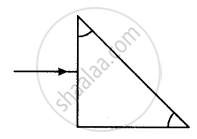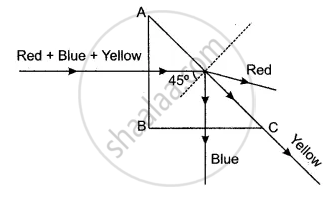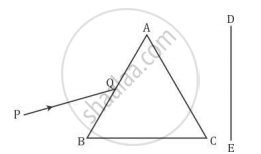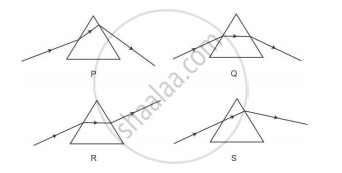Advertisements
Advertisements
प्रश्न
In the diagram, a narrow beam of white light is incident on a right-angled isosceles prism. The critical angle of the material of prism for the yellow colour of white light is 45°. Complete the diagram to show the path of blue, yellow, and red colours of white light till they emerge out of the prism.

उत्तर
The completed diagram is shown below:

The critical angle for yellow light is given to be 45°. Since μblue > μyellow and μred < μyellow so the critical angle for blue light will be less than 45° and for red light will be more than 45°.
APPEARS IN
संबंधित प्रश्न
A narrow beam PQ of white light is passing through a glass prism ABC as shown in the diagram.

Trace it on your answer sheet and show the path of the emergent beam as observed on the screen DE.
(i) Write the name and cause of the phenomenon observed.
(ii) Where else in nature is this phenomenon observed?
(iii) Based on this observation, state the conclusion which can be drawn about the constituents of white light.
Study the following diagrams in which the path of a ray of light passing through a glass prism as traced by four students P, Q, R and S is shown:

The student who has traced the path correctly is
(A) P
(B) Q
(C) R
(D) S
As light rays pass from air into a glass prism, are they refracted towards or away from the normal?
When a beam of white light is passed through a prism, it splits to form lights of seven colours. Is it possible to recombine the lights of seven colours to obtain the white light again? Explain your answer.
A ray of white light falls on a prism. Draw a ray diagram to show that the prism disperses the white light.
In which of the following four diagrams is the correct path of a ray of light passing through a glass prism shown ?
State two uses of ultraviolet radiation.
Define dispersion of light.
The splitting of white light into its component colours is called ____________.
The angle of deviation through a prism is minimum when

- Incident rays and emergent rays are symmetric to the prism.
- The refracted ray inside the prism becomes parallel to its base.
- The angle of incidence is equal to that of the angle of emergence.
- When the angle of emergence has doubled the angle of incidence.
Choose the correct answer from the options given below:
